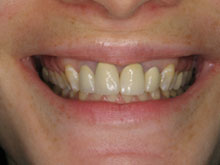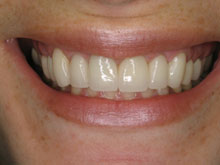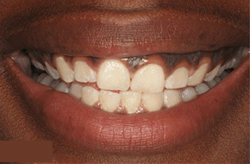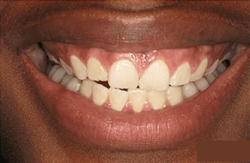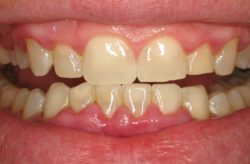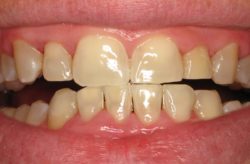Local Antibiotic Therapy
While systemic antibiotics have a very limited use in treating typical periodontal disease, there has been much interest in local antibiotic delivery. If an antibiotic can be delivered directly to the pocket, without the patient having to take systemic doses, there are far fewer side effects, and fewer chances of resistant bacteria forming. In addition, with direct local delivery, the concentration of the antibiotic at the diseased site can be 100 times greater than taking the medication orally. However, it is important to note that all local delivery antibiotics are recommended as adjuncts to scaling and root debridement, and not as stand-alone treatments. Systemic antibiotics are diluted before reaching the pocket. With local application, the antibiotic is inserted directly into the pocket, resulting in much higher concentrations.Actisite
A major difficulty with local antibiotics is keeping the antibiotic at the site for the several days necessary to kill the bacteria. Simply rinsing the pocket with antibiotics does little, and normal pocket fluids flush the antibiotic out of a pocket in less than 2 minutes. This is one reason that mouth rinses are so ineffective in the periodontal pockets. In the last ten years four products have been introduced into this country that allow prolonged drug delivery directly into the pocket. The first introduced was Actisite, a string embedded with tetracycline, a drug known to kill many of the bacteria that cause periodontal disease. The Actisite fiber is placed in the pocket and left for ten days, and during this time high concentrations of tetracycline are released. At the end of 10 days the string is removed from the pocket. Over the next few days the inflammation will subside, and the pocket will ideally shrink as the tissues tighten around the tooth. The major difficulty with Actisite is that the string must be removed, requiring a second appointment. Placement may cause some minor discomfort, requiring a drop of anesthesia, but as with all local delivery products, there is little or no discomfort while the product is in place.





Atridox (controlled released doxycycline hyclate, 10%)
Atridox is a registered trademark of Block Drug Corporation. Atridox is a unique delivery system that uses a gel, which can be injected directly into a pocket. The gel hardens quickly, and then slowly dissolves over the next 7 days, releasing doxycycline. The manufacturer claims that with this system the entire pocket is filled with the antibiotic, which may not be the case with fibers or chips. This appears to be an advantage, although there are some researchers who feel all three systems are effective because the antibiotics diffuse into the pocket fluid, even without direct contact. The product comes in two syringes, one containing 450mg of a liquid polymer, and the other 50mg of doxycycline hyclate, an antibiotic effective against most periodontal pathogens. The syringes are interlocked together, and the contents mixed vigorously. Inserting canula (blunt needle) to prepare for placement Following mixing, a canula is placed on the syringe containing the Atridox, and the material is injected under the gum into the pocket. This generally requires no anesthesia. Atridox being injected into periodontal pocket Atridox sets rapidly on contact with crevicular fluid or blood, and quickly takes on a wax-like consistency. This allows the material to remain in the pocket for 7 days, during which time it dissolves, slowly releasing the antibiotic. To help prevent the product from extruding from the pocket, cyanoacrylate (“super glue”) may be be applied to the gum margin. In some cases a periodontal dressing is placed to help retention. The patient should refrain from brushing and flossing this area for two weeks. During that time chlorhexidine mouthwash is generally recommended. Studies have shown decreased probing depth, reduced bleeding, and improved attachment levels when Atridox is used in conjunction with scaling and planing.



PerioChip

PerioChip is a thin wafer that contains chlorhexidine. While chlorhexidine is not an antibiotic, it is a powerful antiseptic and kills most pathogens. The wafer slides under the edge of the gum into the pocket, a simple procedure that does not require anesthesia. The wafer dissolves over several days, and does not have to be removed.
Arestin
The most recent local antibiotic therapy introduced consists of small spheres of minocycline, a derivative of tetracycline. This drug, similar to the ingredients in Actisite and Atridox, is very effective in killing the bacteria that are thought to cause periodontal disease. The primary advantage of this new product is the ease of use. The spheres, which look like a fine powder, are contained in a small blunt plastic needle, and are injected into the pocket. This requires no anesthesia. The spheres are bioadhesive, and stick to the pocket wall where they slowly release minocycline over a 14-21 day period. Because the spheres are also biodegradable they do not require removal. Generally speaking local delivery antibiotics are used in the Periodontal Maintenance phase of therapy, when isolated areas of the mouth seems to be worsening. Their use is generally not recommended during the active phase of treatment. The effectiveness of these products is somewhat controversial, and while there is usually some improvement, whether these results are long-term has yet to be demonstrated. Certain cases seems to respond better than others, and your periodontist will help advise you whether these treatments may be beneficial in your particular case.



